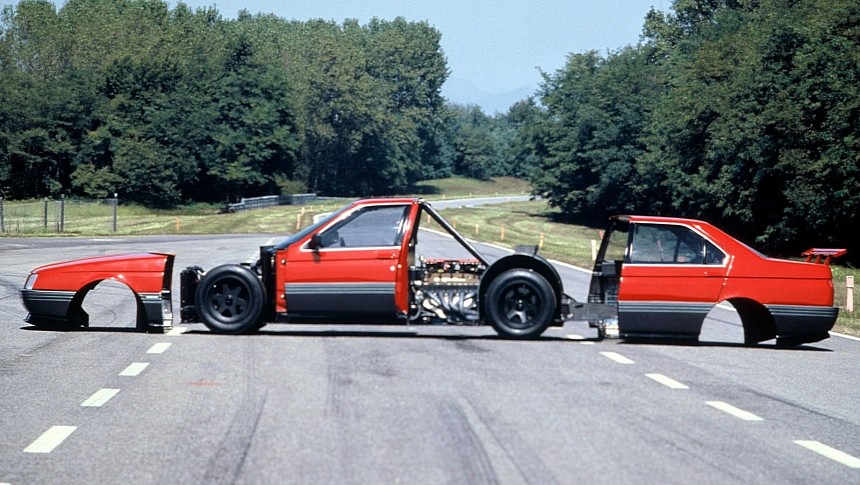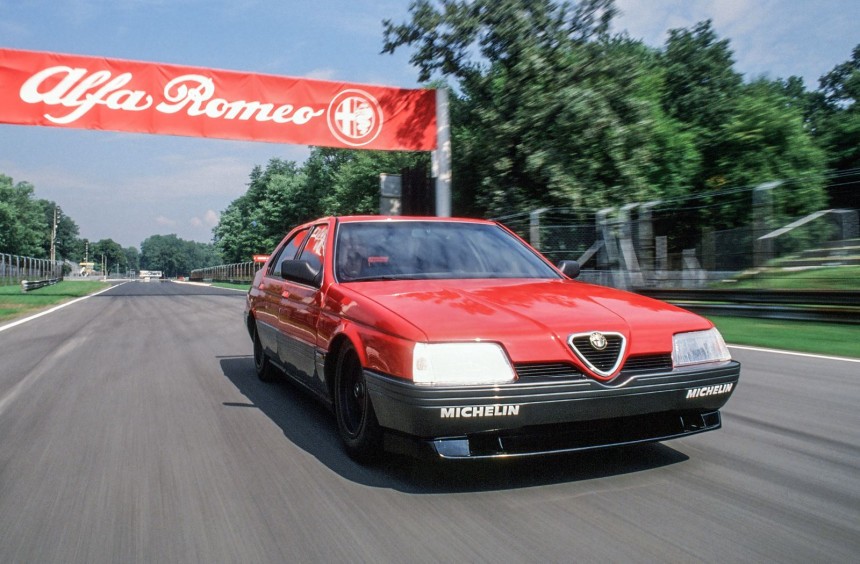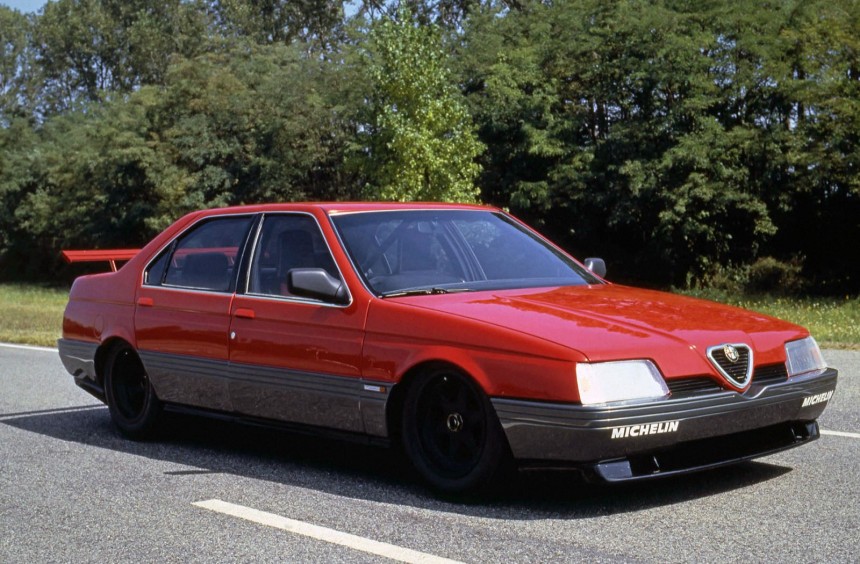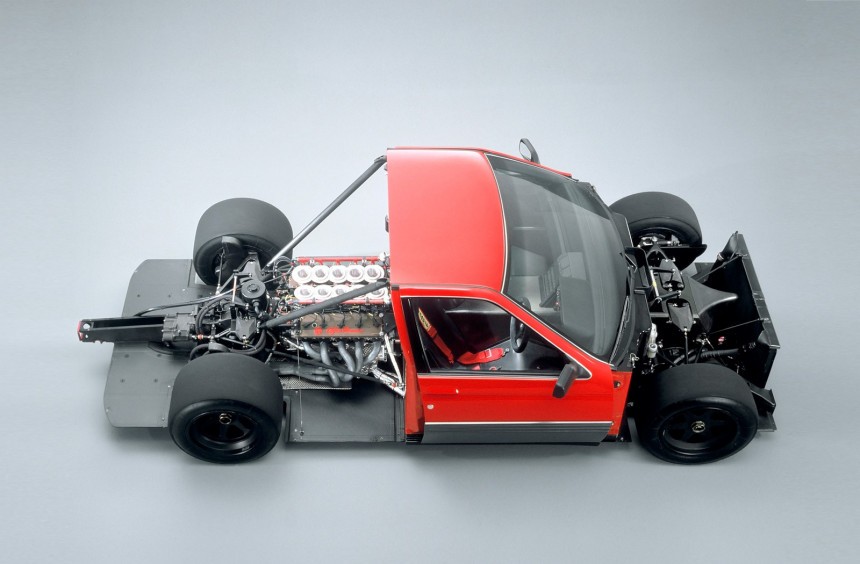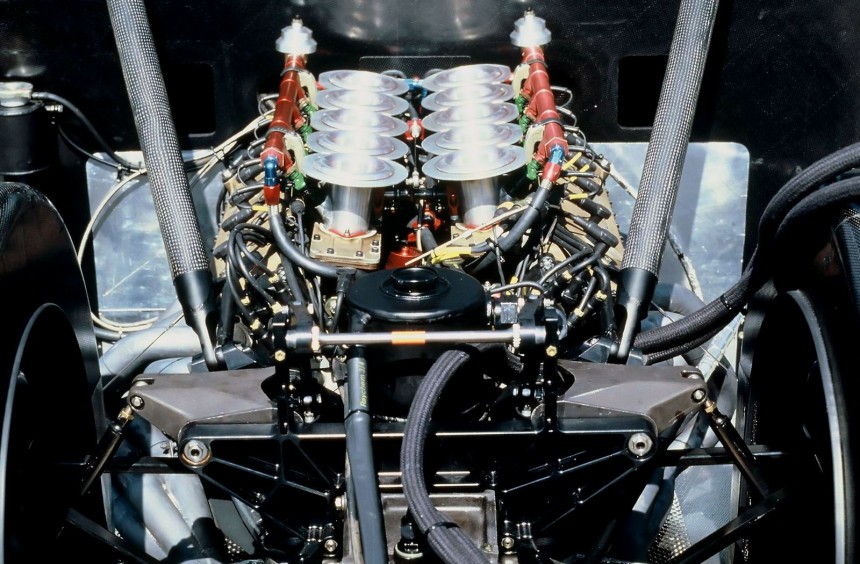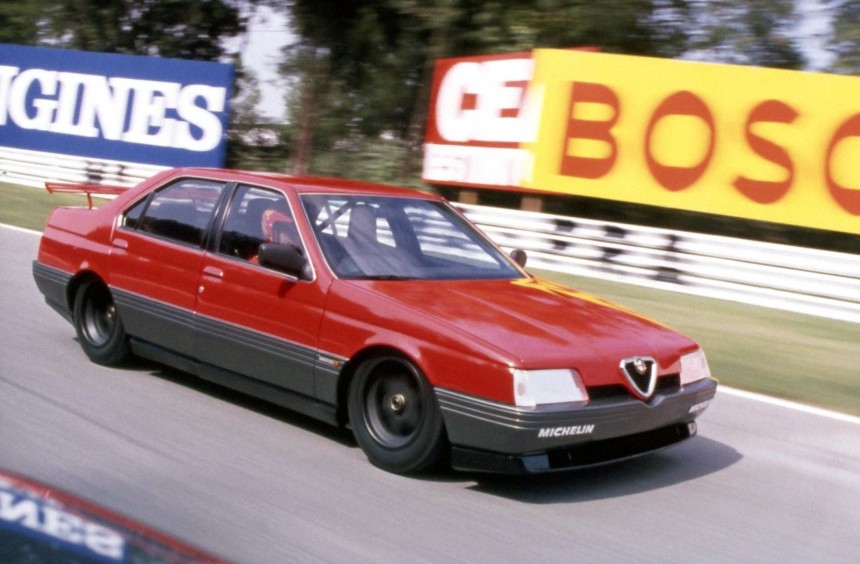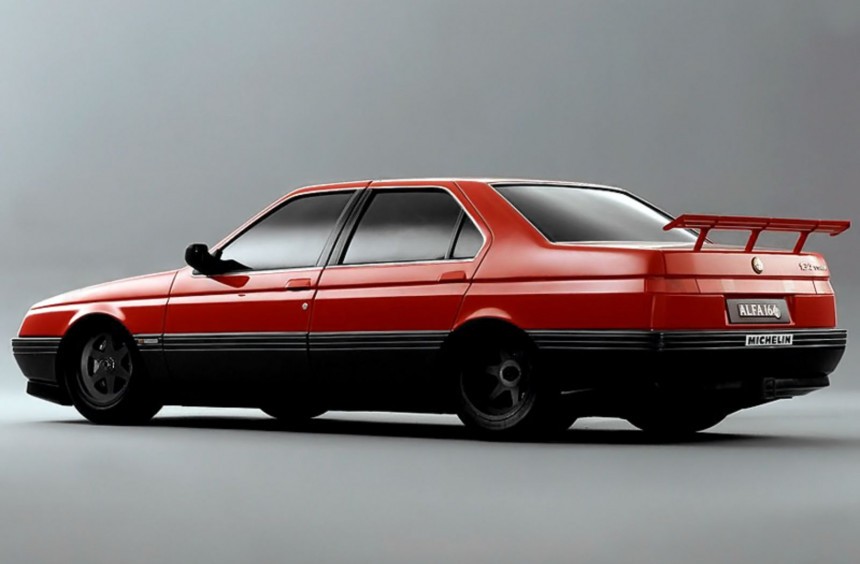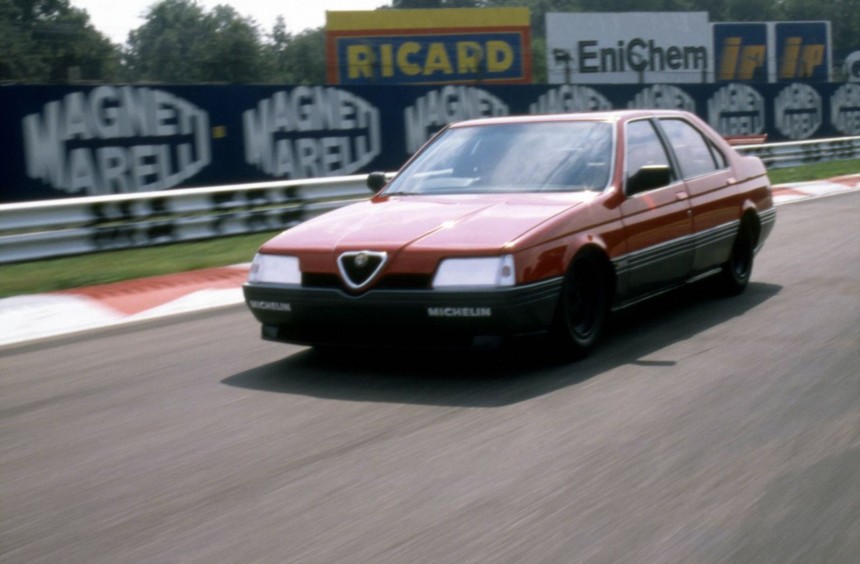During the late 1980s, a failed attempt to launch a support series for the Formula One World Championship gave birth to this insane F1 V10-powered Alfa sedan.
When we think about the greatest vehicle that donned Alfa Romeo badges, iconic models like the TZ2 or the original 33 Stradale come to mind.
While those cars are arguably the most beautiful Alfas ever created, the title of wildest, most insane Alfa ever built goes to the 164 Procar.
Its story starts in the late 1980s when Formula One Constructors Association (FOCA) chief executive and Brabham team owner Bernie Ecclestone proposed the formation of a new competition.
Though it was to be called ProCar, like a similar series that saw F1 drivers compete in race-bred versions of BMW M1 in 1979 and 1980, the new competition proposed a different formula.
No longer a one-make series, the new ProCar was conceived to attract major carmakers to the world of Formula One by running various race cars that loosely resembled mass-production models but featured F1-derived chassis and engines.
To showcase what such a car would look like and what it would take to build it, Ecclestone and his Brabham team partnered with Alfa Corse (Alfa Romeo's motorsport division), creating the world's most rabid sedan.
In 1987, Alfa launched a new, premium four-door sedan codenamed 164, and to help promote it, the company chose the model as the base for the ProCar prototype.
Except for the rear spoiler added to improve aerodynamics, the "Franken-Alfa" looked a lot like the standard model to the untrained eye.
But, while it generally maintained the production car's shape, the 164 ProCar's body was a completely redesigned structure.
Built almost entirely out of a mix of carbon fiber, Kevlar, and Nomex, the structure featured a fixed central section comprising the front doors and windshield.
In addition, the front and rear ends (including faux rear doors and plexiglass windows) were removable, single-piece structures held in place by quick-release latches.
While the bodywork strongly resembled the stock 164, the chassis it covered was completely bespoke.
Designed and manufactured by Brabham with input from race car experts Dallara, the aluminum-strengthened, carbon-Kevlar-Nomex monocoque chassis featured F1-style suspension and braking systems.
Similar to an F1 car's chassis, the structure was modified to accommodate the fixed section of the body, which incorporated a roll cage bonded to the monocoque.
In the middle of the chassis, Alfa Corse engineers placed the part that made the 164 ProCar truly special: a screaming, naturally aspirated V10.
Codenamed Tipo 1035, the DOHC 3.5-liter was an upgraded version of a ten-cylinder prototype engine built in 1985 for the Ligier Formula One team.
Capable of delivering 620 hp at 13,300 RPM and 250 lb-ft (340 Nm) of torque at 9,500 RPM, the V10 never got to compete in F1, as it was deemed too heavy, but it found a place at the heart of Alfa's ProCar project.
Alfa Corse reportedly built two examples, one of which debuted during the 1988 Italian Grand Prix weekend.
Driven by Brabham's F1 ace, Riccardo Patrese, the 1,653-pound (750 kg) 164 ProCar hyped the crowd at Monza with its unmistakable, high-revving, ten-cylinder symphony.
According to Alfa Romeo, it could sprint to 60 mph (97 kph) in just a little over two seconds. Even more impressive, it could reach a top speed of 211 mph (340 kph) and ran the quarter mile in 9.7 seconds.
But, while it was blistering fast and rode on an F1-style suspension, it didn't generate enough downforce to translate that speed into corners.
Patrese found it hard to tame through high-speed corners during tests, losing control on multiple occasions.
However, the engineering teams had some modifications in mind for the final ProCar championship version.
Unfortunately, the engineers never got to employ these modifications, as the project was eventually halted in late 1988.
Despite his efforts, Ecclestone failed to get other manufacturers to commit to ProCar, so eventually, the support series never became a reality.
While it's unclear what happened to the first 164 ProCar chassis, the second, which graced the track at Monza, was eventually displayed at Alfa Romeo's museum.
The race-bred V10, at the heart of the project, was later used in the early development phase of the Alfa Romeo SE 048SP Group C prototype - another project halted in its tracks.
Though it never got to compete against similar silhouette race cars, it became an unforgettable icon for die-hard Alfisti.
However, excluding the brand's enthusiasts, the 164 ProCar has been largely forgotten.
With its plebian sedan look and mid-mounted, F1-derived V10, the ProCar remains one of Alfa Romeo's most epic projects.
It deserves to be remembered and celebrated since we won't be seeing a carmaker building something similar in the era of electrification.
If you want to learn more about this fantastic car, we recommend watching the YouTube video below by Roadster Life.
While those cars are arguably the most beautiful Alfas ever created, the title of wildest, most insane Alfa ever built goes to the 164 Procar.
Its story starts in the late 1980s when Formula One Constructors Association (FOCA) chief executive and Brabham team owner Bernie Ecclestone proposed the formation of a new competition.
The new ProCar series
No longer a one-make series, the new ProCar was conceived to attract major carmakers to the world of Formula One by running various race cars that loosely resembled mass-production models but featured F1-derived chassis and engines.
To showcase what such a car would look like and what it would take to build it, Ecclestone and his Brabham team partnered with Alfa Corse (Alfa Romeo's motorsport division), creating the world's most rabid sedan.
An Alfa Romeo 164 on steroids
Except for the rear spoiler added to improve aerodynamics, the "Franken-Alfa" looked a lot like the standard model to the untrained eye.
But, while it generally maintained the production car's shape, the 164 ProCar's body was a completely redesigned structure.
Built almost entirely out of a mix of carbon fiber, Kevlar, and Nomex, the structure featured a fixed central section comprising the front doors and windshield.
In addition, the front and rear ends (including faux rear doors and plexiglass windows) were removable, single-piece structures held in place by quick-release latches.
A bespoke, F1-derived chassis
Designed and manufactured by Brabham with input from race car experts Dallara, the aluminum-strengthened, carbon-Kevlar-Nomex monocoque chassis featured F1-style suspension and braking systems.
Similar to an F1 car's chassis, the structure was modified to accommodate the fixed section of the body, which incorporated a roll cage bonded to the monocoque.
Powered by Alfa's last F1 V10
Codenamed Tipo 1035, the DOHC 3.5-liter was an upgraded version of a ten-cylinder prototype engine built in 1985 for the Ligier Formula One team.
Capable of delivering 620 hp at 13,300 RPM and 250 lb-ft (340 Nm) of torque at 9,500 RPM, the V10 never got to compete in F1, as it was deemed too heavy, but it found a place at the heart of Alfa's ProCar project.
Frightenly fast and hard to tame
Driven by Brabham's F1 ace, Riccardo Patrese, the 1,653-pound (750 kg) 164 ProCar hyped the crowd at Monza with its unmistakable, high-revving, ten-cylinder symphony.
According to Alfa Romeo, it could sprint to 60 mph (97 kph) in just a little over two seconds. Even more impressive, it could reach a top speed of 211 mph (340 kph) and ran the quarter mile in 9.7 seconds.
But, while it was blistering fast and rode on an F1-style suspension, it didn't generate enough downforce to translate that speed into corners.
Patrese found it hard to tame through high-speed corners during tests, losing control on multiple occasions.
However, the engineering teams had some modifications in mind for the final ProCar championship version.
Halted in its tracks
Despite his efforts, Ecclestone failed to get other manufacturers to commit to ProCar, so eventually, the support series never became a reality.
While it's unclear what happened to the first 164 ProCar chassis, the second, which graced the track at Monza, was eventually displayed at Alfa Romeo's museum.
The race-bred V10, at the heart of the project, was later used in the early development phase of the Alfa Romeo SE 048SP Group C prototype - another project halted in its tracks.
An epic car that deserves to be remembered
However, excluding the brand's enthusiasts, the 164 ProCar has been largely forgotten.
With its plebian sedan look and mid-mounted, F1-derived V10, the ProCar remains one of Alfa Romeo's most epic projects.
It deserves to be remembered and celebrated since we won't be seeing a carmaker building something similar in the era of electrification.
If you want to learn more about this fantastic car, we recommend watching the YouTube video below by Roadster Life.
